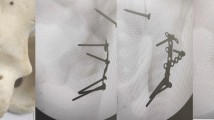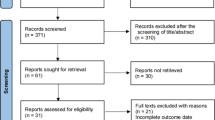Abstract
Purpose
Surgical procedures on atlantoaxial dislocation remain controversial. The aim of this observational retrospective study was to investigate the treatment algorithm of surgical procedures.
Methods
According to CT and intraoperative evaluation during direct posterior reduction, 135 AAD cases were categorized into three groups: Group I: reducible dislocation; Group II: irreducible dislocation (Group IIa: effective decompression achieved after posterior reduction; Group IIb: no effective decompression after posterior reduction); and Group III: fixed dislocation. Group III presented with extensive bony fusions. Group I and Group IIa were treated with direct posterior reduction and fixation. Group IIb underwent posterior fixation and transoral odontoidectomy. Group III underwent transoral odontoidectomy alone. Japanese Orthopedic Association scores (JOA) were assessed to evaluate clinical status before and 6, 12 months after surgery.
Results
Our study included 118 Group I cases, 16 Group II cases (Group IIa: 11 cases; Group IIb: 5 cases), and one Group III case. Follow-up ranged from 12 to 36 months. Primary outcome: Anatomic atlantoaxial reduction was achieved in 118 of 135 patients (87.4%). Clinical improvements were seen in 96.3% (130/135) all the patients. Solid atlantoaxial fusion was shown in 134 patients. Secondary outcome: The overall complication rate was 3.7% (5/135). For Group I, the mean postoperative 6-month JOA was 14.5 versus 12.2 in preoperative patients (paired Student’s t test, P < 0.01).
Conclusions
This article proposes a clinical procedure that assists with therapeutic decision making and indicates the severity and difficulty of reduction of the atlantoaxial joint.
Graphical abstract
These slides can be retrieved under Electronic Supplementary Material.






Similar content being viewed by others
References
Resnick DK, Agrawal BM (2012) Atlantoaxial dislocation. Neurol India 24(3):106–107
Yang SY, Boniello AJ, Poorman CE, Chang AL, Wang S, Passias PG (2014) A review of the diagnosis and treatment of atlantoaxial dislocations. Glob Spine J 4(3):197–210
Bouchaudchabot A, Lioté F (2002) Cervical spine involvement in rheumatoid arthritis. A review. Joint Bone Spine 69(2):141–154
Menezes AH, Vangilder JC, Graf CJ, Mcdonnell DE (1980) Craniocervical abnormalities. A comprehensive surgical approach. J Neurosurg 53(4):444–455
Venkatesan M, Bhatt R, Newey ML (2012) Traumatic atlantoaxial rotatory subluxation (TAARS) in adults: a report of two cases and literature review. Injury 43(7):1212–1215
Greenberg AD (1968) Atlanto-axial dislocations. Brain A J Neurol 91(4):655
Salunke P, Sahoo S, Khandelwal NK, Ghuman MS (2015) Technique for direct posterior reduction in irreducible atlantoaxial dislocation: multi-planar realignment of C1–2. Clin Neurol Neurosurg 131:47–53
Yin YH, Qiao GY, Yu XG, Tong HY, Zhang YZ (2013) Posterior realignment of irreducible atlantoaxial dislocation with C1–C2 screw and rod system: a technique of direct reduction and fixation. Spine J 13(12):1864–1871
Wang C, Yan M, Zhou HT, Wang SL, Dang GT (2006) Open reduction of irreducible atlantoaxial dislocation by transoral anterior atlantoaxial release and posterior internal fixation. Spine 31(11):E306
Xu J, Yin Q, Xia H, Wu Z, Ma X, Zhang K, Wang Z, Yang J, Ai F, Wang J (2013) New clinical classification system for atlantoaxial dislocation. Orthopedics 36(1):E95–E100
Yin QS, Wang JH (2015) Current trends in management of atlantoaxial dislocation. Orthop Surg 7(3):189–199
Jian FZ, Chen Z, Wrede KH, Samii M, Ling F (2010) Direct posterior reduction and fixation for the treatment of basilar invagination with atlantoaxial dislocation. Neurosurgery 66(4):678
Chandra PS, Kumar A, Chauhan A, Ansari A, Mishra NK, Sharma BS (2013) Distraction, compression, and extension reduction of basilar invagination and atlantoaxial dislocation: a novel pilot technique. Neurosurgery 72(6):1040
Suh BG, Padua MR, Riew KD, Kim HJ, Chang BS, Lee CK, Yeom JS (2013) A new technique for reduction of atlantoaxial subluxation using a simple tool during posterior segmental screw fixation. J Neurosurg Spine 19(2):160–166
Goel A, Kulkarni AG, Sharma P (2005) Reduction of fixed atlantoaxial dislocation in 24 cases: technical note. J Neurosurg Spine 2(4):505
Goel A, Desai KI, Muzumdar DP (2002) Atlantoaxial fixation using plate and screw method: a report of 160 treated patients. Neurosurgery 51(6):1351–1356 (discussion 1356–1357)
Harms J, Melcher RP (2001) Posterior C1–C2 fusion with polyaxial screw and rod fixation. Spine 26(22):2467
Abumi K, Takada T, Shono Y, Kaneda K, Fujiya M (1999) Posterior occipitocervical reconstruction using cervical pedicle screws and plate-rod systems. Spine 24(14):1425–1434
Wang Z, Wang X, Jian F, Zhang C, Wu H, Chen Z (2016) The changes of syrinx volume after posterior reduction and fixation of basilar invagination and atlantoaxial dislocation with syringomyelia. Eur Spine J 26(4):1–9
Bo X, Wang W, Chen Z, Liu Z (2016) Compression-distraction reduction surgical verification and optimization to treat the basilar invagination and atlantoaxial dislocation: a finite element analysis. Biomed Eng Online 15(Suppl 2):383–397
Salunke P, Sahoo SK, Deepak AN, Ghuman MS, Khandelwal NK (2015) Comprehensive drilling of the C1–2 facets to achieve direct posterior reduction in irreducible atlantoaxial dislocation. J Neurosurg Spine 23(3):1
Menezes AH (2008) Surgical approaches: postoperative care and complications “transoral-transpalatopharyngeal approach to the craniocervical junction”. Childs Nerv Syst 24(10):1187–1193
Subin B, Liu JF, Marshall GJ, Huang HY, Ou JH, Xu GZ (1995) Transoral anterior decompression and fusion of chronic irreducible atlantoaxial dislocation with spinal cord compression. Spine 20(11):1233
Shriver MF, Kshettry VR, Sindwani R, Woodard T, Benzel EC, Recinos PF (2016) Transoral and transnasal odontoidectomy complications: a systematic review and meta-analysis. Clin Neurol Neurosurg 148:121–129
Laheri V, Chaudhary K, Rathod A, Bapat M (2015) Anterior transoral atlantoaxial release and posterior instrumented fusion for irreducible congenital basilar invagination. Eur Spine J 24(12):2977–2985
Wang S, Wang C, Yan M, Zhou H, Dang G (2013) Novel surgical classification and treatment strategy for atlantoaxial dislocations. Spine 38(21):1348–1356
Visocchi M, Pietrini D, Tufo T, Fernandez E, Rocco CD (2009) Pre-operative irreducible C1–C2 dislocations: intra-operative reduction and posterior fixation. The “always posterior strategy”. Acta Neurochir 151(5):551–559
Srivastava SK, Aggarwal RA, Nemade PS, Bhosale SK (2016) Single-stage anterior release and posterior instrumented fusion for irreducible atlantoaxial dislocation with basilar invagination. Spine J 16(1):1–9
Kumar R, Nayak SR (2002) Management of pediatric congenital atlantoaxial dislocation: a report of 23 cases from Northern India. Pediatr Neurosurg 36(4):197–208
Salunke P, Behari S, Kirankumar MV, Sharma MS, Jaiswal AK, Jain VK (2006) Pediatric congenital atlantoaxial dislocation: differences between the irreducible and reducible varieties. J Neurosurg 104(2 Suppl):115
Deepak AN, Salunke P, Sahoo SK, Prasad PK, Khandelwal NK (2016) Revisiting the differences between irreducible and reducible atlantoaxial dislocation in the era of direct posterior approach and C1–2 joint manipulation. J Neurosurg Spine 26(3):1
Madawi AA, Casey AT, Solanki GA, Tuite G, Veres R, Crockard HA (1997) Radiological and anatomical evaluation of the atlantoaxial transarticular screw fixation technique. J Neurosurg 86(6):961
Wright NM, Stewart TJ (2008) Techniques of posterior C1–C2 stabilization. Neurosurgery 62(6):103–111
Guan J, Chen Z, Wu H, Yao Q, Zhang C, Qi T, Wang K, Duan W, Gao J, Li Y, Jian F (2018) Is anterior release and cervical traction necessary for the treatment of irreducible atlantoaxial dislocation? A systematic review and meta-analysis. Eur Spine J 27(6):1234–1248. https://doi.org/10.1007/s00586-018-5563-7
Funding
This research was funded by the innovative plan of Beijing Hospital Authority (Grant ID: PX2017002); general project of Beijing Natural Science Foundation (Grant ID: 7172091); Capital developmental innovation project of Beijing Municipal Commission of Health and Family Planning (Grant ID: SHOUFA-2018-2-2014).
Author information
Authors and Affiliations
Corresponding author
Ethics declarations
Conflict of interest
The authors report no conflict of interest concerning the materials or methods used in this study or the findings specified in this paper.
Electronic supplementary material
Below is the link to the electronic supplementary material.
Rights and permissions
About this article
Cite this article
Guan, J., Chen, Z., Wu, H. et al. Effectiveness of posterior reduction and fixation in atlantoaxial dislocation: a retrospective cohort study of 135 patients with a treatment algorithm proposal. Eur Spine J 28, 1053–1063 (2019). https://doi.org/10.1007/s00586-018-05869-z
Received:
Accepted:
Published:
Issue Date:
DOI: https://doi.org/10.1007/s00586-018-05869-z




